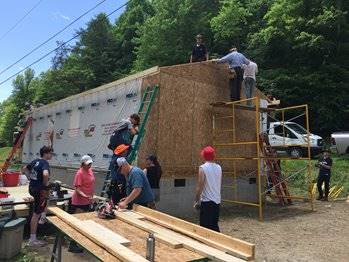The 2021 Wayne County, West Virginia, mission trip was, in many ways, a dream deferred. Planned for last summer for rising juniors, the weeklong venture was postponed throughout the rise of the coronavirus pandemic.
As those students persevered through the past school year, while many other opportunities became impossible to see through, their trip remained ripe with possibility.
“I was very glad that it was able to happen,” says Terry McCafferty ’22. “I felt excited about the opportunity and open to the potential of what the experience could be.”
Science teacher Guy Savastano has been leading trips to Wayne County for 15 years and brought the trip to Saint Ignatius in 2019. He and Director of Campus Ministry Augie Pacetti ’96, who had planned to chaperone the students last year, invited the same group of guys to make the trip one year later.
 Seven obliged and, in early June, they departed Cleveland for Wayne County Work Camp in Appalachia. Run by Cabwaylingo Presbyterian Chapel in Dunlow, West Virginia, the work camp is “a summer service experience for teens and adults who desire a hands-on opportunity to put their Christian faith into practice by serving those in need.” It’s a collaborative effort involving volunteers from across the country.
Seven obliged and, in early June, they departed Cleveland for Wayne County Work Camp in Appalachia. Run by Cabwaylingo Presbyterian Chapel in Dunlow, West Virginia, the work camp is “a summer service experience for teens and adults who desire a hands-on opportunity to put their Christian faith into practice by serving those in need.” It’s a collaborative effort involving volunteers from across the country.
The Saint Ignatius group’s work for the week was in helping build a home for a poor family. And while that work involved power tools and safety gear, it also focused around hearing others’ stories, building relationships and prayer.
“I was moved by how much poverty there was in the area we were in, yet I was also moved by how the people we met were still happy with what they had,” says Dominic DeBlasis ’22. “I was inspired by the camp that we were staying at, as the couple that runs the camp—Bill and Addie Likens—has such a large presence in the community, building houses, donating food, and being a place of love and companionship for youth, along with all people in the community.”
Students were split up into three work crews and were literally involved in the construction of a small home. That meant learning new skills involved in a significant building project, including the use of power tools. More than that, however, it was about doing right by a man and his family whose family has long called West Virginia home.
“The house was for Nelson and his family. When I talked to Nelson he was so appreciative of what we were doing,” Terry says. “The tree-covered hills and the sweet misty air make it a beautiful place to be, especially for families who have lived on the land for generations. At the same time, the social and economic hardships faced by the region do not make life easy for the people who live there. By building a house for Nelson and his family, we were able to meet their needs exactly where they needed to be met by building them a new physical house to move into while keeping them on the land that is their home.”
Throughout the summer, students from a variety of high schools and even colleges were making the trip to West Virginia to assist with similar home-building projects. Pacetti and Savastano guided the Saint Ignatius students as they learned about the struggles of poverty in the region, and spent time daily in prayer and reflection.
 “I have so many wonderful things, like food, clothes, school, and other needs and wants that I can afford while people, like those we met in West Virginia, can barely afford to live in a small but decent home,” Dominic says. “This shows me why part of the Church’s mission is to serve the poor (in this case the physically poor) as the poor are most in need of necessities, and also of companionship.”
“I have so many wonderful things, like food, clothes, school, and other needs and wants that I can afford while people, like those we met in West Virginia, can barely afford to live in a small but decent home,” Dominic says. “This shows me why part of the Church’s mission is to serve the poor (in this case the physically poor) as the poor are most in need of necessities, and also of companionship.”
As Terry explains it, they didn’t go to West Virgina to solve poverty or simply observe it as an outsider—it was about being in solidarity with those in need and finding concrete ways to help.
“In the grand scheme of things, the construction of a single house might seem to have a relatively minor impact in a world where so many people are in need, but for the family who got the house, the impact over the years will be incredible,” he says. “It took a big group of a lot of different people working together to make it happen, and I feel blessed to have been a part of it.”